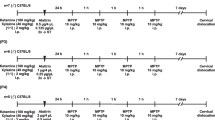Summary
Although controversial, studies with methamphetamine and MPTP suggest a link between glutamate-mediated excitotoxicity and degeneration of dopamine cells. Both compounds are thonght to create a metabolic stress. To further explore glutamate actions in DA degeneration, we investigated the effects of other metabolic inhibitors. In mesencephalic cultures, DA cell loss produced by 3-NPA or malonate was potentiated by NMDA and prevented by MK-801. In vivo, striatal DA loss produced by intranigral infusions of malonate was also potentiated by intranigral NMDA and prevented by systemic MK-801. In contrast, systemic MK-801 did not prevent DA loss produced by intrastriatal malonate. Intrastriatal MK-801 or CGS 19755 did attenuate DA loss in METH-treated mice, but was confounded by the findings that METH-induced hyperthermia, an important component in toxicity, was also attenuated. Taken together, the data support the hypothesis of NMDA receptor involvement in degeneration of DA neurons. Furthermore, the data also suggest that this interaction is likely to occur in the substantia nigra rather than in the striatum.
Similar content being viewed by others
References
Albers DA, Sonsalla PK (1995) Methamphetamine-induced hyperthermia and dopaminergic neurotoxicity in mice: pharmacological profile of protective and nonprotective agents. J Pharmacol Exp Ther 275: 1104–1114
Bowyer JF, Davies DL, Schmued L, Broening HW, Newport GD, Sliker, W jr. Holson RR (1994) Further studies of the role of hyperthermia in methamphetamine neurotoxicity. J Pharmacol Exp Ther 268: 1571–1580
Chan P, Di Monte DA, Luo J-J, DeLanney LE, Irwin I, Langston JW (1994) Rapid ATP loss caused by methamphetamine in the mouse striatum: relationship between energy impairment and dopaminergic neurotoxicity. J Neurochem 62: 2484–2487
Chan P, Di Monte DA, Langston JW, Janson AM (1997) (+)MK-801 does not prevent MPTP-induced loss of nigral neurons in mice. J Pharmacol Exp Ther 280: 439–446
Pang Z, Geddes JW (1997) Mechanisms of cell death induced by the mitochondrial toxin 3-nitroproionic acid: acute excitotoxic necrosis and delayed apoptosis. J Neurosci 17: 3064–3073
Novelli A, Reilly JA, Lysko PG, Henneberry RC (1988) Glutamate becomes neurotoxic via the NMDA receptor when intracellular energy levels are reduced. Brain Res 451: 205–212
Sonsalla PK, Nicklas WJ (1992) MPTP and animal models of Parkinson's disease. In: Koller WC (ed) Handbook of Parkinson's disease, 2nd edn. Marcel Dekker, New York, pp 319–340
Sonsalla PK, Nicklas WJ, Heikkila RE (1989) Role for excitatory amino acids in methamphetamine-induced nitrostriatal dopaminergic neurotoxicity. Science 243: 398–400
Sonsalla PK, Riordan DE, Heikkila RE (1991) Competetive and noncompetitive antagonists at N-methyl-D-aspartate receptors protect against methamphetamine-induced dopaminergic damage in mice. J Pharmacol Exp Ther 256: 506–512
Zeevalk GD, Nicklas WJ (1991) Mechanisms underlying initiation of excitototxicity associated with metabolic inhibition. J Pharmacol Exp Ther 257: 870–878
Zeevalk GD, Derr-Yellin E, Nicklas WJ (1995a) NMDA receptor involvement in toxicity to dopamine neuronsin vitro caused by the succinate dehydrogenase inhibitor 3-nitroproprionic acid. J Neurochem 64: 455–458
Zeevalk GD, Derr-Yellin E, Nicklas WJ (1995b) Relative vulnerability of dopamine and GABA neurons in mesencephalic culture to inhibition of succinate dehydrogenase by malonate and 3-nitroproprionic acid and protection by NMDA receptor blockade. J Pharmacol Exp Ther 275: 1124–1130
Zeevalk GD, Manzino L, Hoppe J, Sonsalla PK (1997)In vivo vulnerability of dopamine neurons to inhibition of energy metabolism. Eur J Pharmacol 320: 111–119
Author information
Authors and Affiliations
Rights and permissions
About this article
Cite this article
Sonsalla, P.K., Albers, D.S. & Zeevalk, G.D. Role of glutamate in neurodegeneration of dopamine neurons in several animal models of parkinsonism. Amino Acids 14, 69–74 (1998). https://doi.org/10.1007/BF01345245
Received:
Accepted:
Issue Date:
DOI: https://doi.org/10.1007/BF01345245




